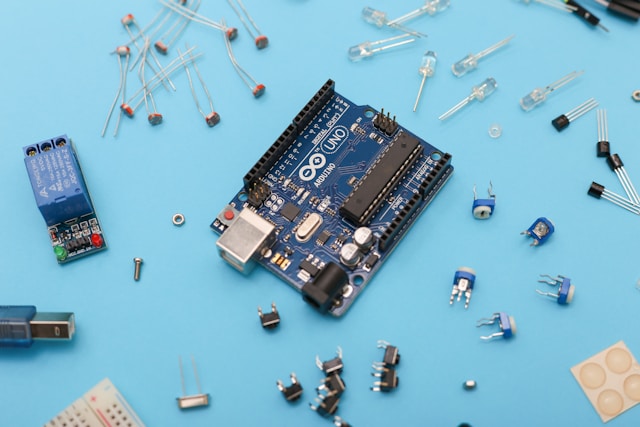- Change theme
Pick-and-Place Machines: How They Revolutionize SMT PCB Assembly

In the world of electronics manufacturing, speed and precision are everything.
08:25 12 August 2025
In the world of electronics manufacturing, speed and precision are everything. As devices become smaller and more complex, the process of assembling printed circuit boards (PCBs) must be faster, more accurate, and more reliable than ever before. One of the biggest breakthroughs in achieving this has been the development of pick-and-place machines — automated systems that have completely transformed SMT PCB assembly.
In this article, we’ll explore what pick-and-place machines are, how they work, the different types available, and why they’re essential for producing today’s high-performance electronics.
What Is a Pick-and-Place Machine?
A pick-and-place machine is a robotic system used in Surface-Mount Technology (SMT) to pick up surface-mount devices (SMDs) and place them precisely on a PCB. Instead of manually positioning each component — a slow and error-prone process — these machines use high-speed robotic arms, suction nozzles, and vision systems to automate the placement process.
- Speed: Modern pick-and-place machines can place tens of thousands of components per hour.
- Accuracy: Placement precision is often within ±0.05 mm.
- Versatility: They can handle components ranging from large integrated circuits to microscopic resistors.
How Pick-and-Place Machines Work
The process involves several coordinated steps:
- Feeder Setup
Components are loaded into feeders, which hold them in reels, tubes, or trays. The machine pulls components from these feeders as needed. - Vision Alignment
Cameras inspect both the PCB and the components, ensuring exact alignment. Advanced vision systems can detect polarity, orientation, and part number. - Component Pickup
A robotic arm with vacuum nozzles picks up each component from the feeder. - Placement
The machine positions the component over the PCB pad and releases it onto the solder paste. - Continuous Feedback
Sensors and cameras provide real-time feedback to correct any misalignments instantly.
Types of Pick-and-Place Machines
Manufacturers use different types of machines depending on their production needs:
- Manual Pick-and-Place Machines
- Used for prototypes or small-scale production.
- Operators manually move the head to place components.
- Inexpensive but slow and labor-intensive.
- Semi-Automatic Pick-and-Place Machines
- Combine manual loading with automated alignment and placement.
- Suitable for mid-volume production.
- Fully Automatic Pick-and-Place Machines
- Fully robotic with high-speed operation.
- Ideal for large-scale, high-volume manufacturing.
- Feature-rich, with multiple placement heads and advanced vision systems.
Advantages of Pick-and-Place Machines in SMT PCB Assembly
The introduction of pick-and-place technology has brought numerous benefits:
- Massive Speed Increase – Replacing manual labor with automation cuts production time dramatically.
- Unmatched Precision – Ensures components are perfectly aligned before soldering.
- Reduced Human Error – Automation minimizes mistakes caused by fatigue or inattention.
- Flexibility – Can quickly adapt to different PCB layouts and component sizes.
- Cost-Effectiveness – Lower labor costs and higher yields reduce the total cost of production.
Integration with Other SMT Processes
Pick-and-place machines don’t work alone — they are part of a larger automated SMT line:
- Before Placement: Solder paste is applied to the PCB using stencil printing.
- After Placement: The board goes into a reflow oven to solder the components in place.
- Inspection: Automated Optical Inspection (AOI) systems check for placement defects.
This integration ensures a seamless, high-efficiency workflow from start to finish.
Challenges in Using Pick-and-Place Machines
Even with advanced automation, there are challenges to consider:
- Feeder Setup Time: Changing component reels for different jobs can slow down production.
- Component Handling: Extremely small or fragile parts require specialized nozzles and careful handling.
- Machine Maintenance: Regular cleaning and calibration are essential for consistent performance.
- Cost: High-end machines are expensive, though they pay off in high-volume production.
The Role of Software in Modern Pick-and-Place Systems
Today’s pick-and-place machines are driven by sophisticated software:
- Job Programming: Operators upload design files (Gerber or CAD data) to program the placement sequence.
- Optimization Algorithms: The software determines the fastest placement route to minimize movement.
- Real-Time Monitoring: Detects and corrects errors on the fly.
- Data Analytics: Tracks performance, defect rates, and production metrics for continuous improvement.
Future of Pick-and-Place Technology
As electronics continue to evolve, so will pick-and-place machines:
- Higher Placement Speeds: Future machines will surpass current speed records without sacrificing accuracy.
- AI Vision Systems: Artificial intelligence will enhance defect detection and placement correction.
- Microelectronics Capability: Machines will handle even smaller, more delicate components for advanced applications like wearable tech and medical devices.
- Integration with Industry 4.0: Real-time data sharing with other factory systems for fully connected manufacturing.
Conclusion
Pick-and-place machines have revolutionized SMT PCB assembly, making it possible to produce millions of high-quality, compact, and reliable devices quickly and efficiently. Their combination of speed, accuracy, and flexibility ensures they remain at the heart of modern electronics manufacturing.
Whether you’re building prototypes or mass-producing consumer gadgets, investing in advanced pick-and-place technology is one of the smartest decisions any electronics manufacturer can make.
